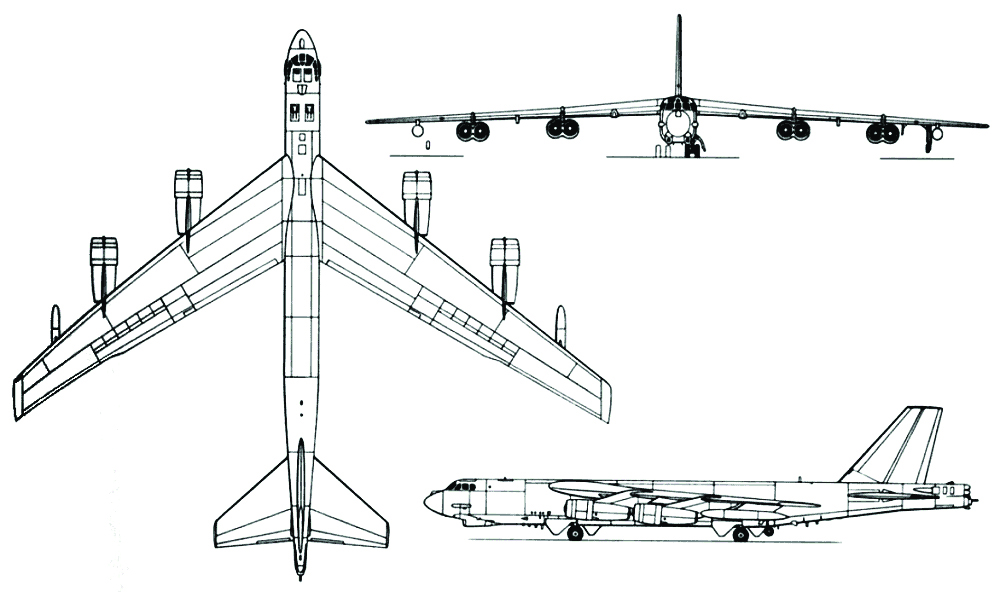Though the aircraft is 159′ long with a crew of five, the Stratofortress does not have a toilet. Crewmen instead use bags which are then disposed of upon return to base.
The B-52 is a long-range, heavy bomber. Unlike previous bombers, B-52s carry air-launched cruise missiles (ALCM), which reduce the risk of enemy fire by allowing B-52s to launch bombs farther from their targets. The B-52 first flew in 1952 and is expected to remain in the United States Air Force (USAF) fleet until 2040. One hundred and ninety-three B-52Gs were built—more than any other version of the Stratofortress. The B-52G was sent to Southeast Asia to support the bombing of North Vietnam in April 1972, where it participated in Operation Linebacker I and II. In the Persian Gulf Wars, about eighty B-52Gs operated from bases in the Middle East, Spain and Great Britain. They flew 1,620 sorties with no losses to enemy fire even though several sustained damage.

Serial Number: 58-0191
Manufacturer: Boeing
Crew: Six
Engines: Eight Pratt & Whitney J57-P-43WB turbojets, 13,750 pounds thrust each with water injection
Wingspan: 185 feet
Length: 160 feet 10.9 inches
Height: 40 feet 8 inches
Weight: 168,445 pounds (empty); 488,000 pounds (maximum)
Speed: 523 mph (cruising); 636 mph (maximum at 20,800 feet)
Range: 4,100 miles with a 10,000-pound bomb load; 7,976 miles ferry
Service Ceiling: 47,000 feet
Armament: Four .5-inch machine guns; payload 50,000 pounds of bombs and missiles
Cost: $30,000,000 (approximate)
In 1971, Hill Air Force Base became one of six bases hosting new satellite alert facilities for the B-52 bomber force. Four B-52s were assigned to the 456th Bombardment Wing (Heavy). The first of the four B-52 Stratofortress bombers assigned to the detachment arrived at the base in December 1973 and continued to function until July 1975. Today, Hill Air Force Base maintains and manages the B-52H’s landing gear, wheels, tires and brakes.
Nicknamed “Bearing Arms,” the B-52G located at Hill Aerospace Museum was manufactured by Boeing in Wichita, Kansas, and delivered to the USAF in October 1959. It was first assigned to the 72nd Bombardment Wing (Heavy) at Ramey Air Force Base in May 1962, but later returned to the Boeing factory for wing modification and strengthening to counteract the fatigue cracks occurring in the B-52 fleet.
After modifications, the aircraft was stationed at Beale Air Force Base with the 456th Bombardment Wing (Heavy). The 456th completed deployments to Anderson Air Base, Guam, with this aircraft. After seven transfers to different units, spanning more than 20 years, it moved to its final duty station with the 93rd Bombardment Wing (Heavy) at Castle Air Force Base in December 1988.
Finally, in 1991, the USAF dropped the “Bearing Arms” from its inventory and made it available to the United States Air Force Museum Program. In that same year, the B-52G’s final flight was from Castle Air Force Base to Hill Air Force Base to be placed on display at Hill Aerospace Museum.
Though the aircraft is 159′ long with a crew of five, the Stratofortress does not have a toilet. Crewmen instead use bags which are then disposed of upon return to base.
During the 10-year conflict in Vietnam, some 30 B-52s were shot down. However, in a shocking twist, two MiG-21 fighters were shot down by the tail gunners onboard the Stratofortress.
The last B-52 rolled off the assembly line in October 1962 in Seattle, Washington and Wichita, Kansas.
The Stratofortress was the last American bomber to feature weapons used in self-defense. By 1992, the Air Force made the decision to remove the weapons, since the advent of long-range, surface-to-air missiles and multiple defensive technologies had rendered the weapons obsolete.